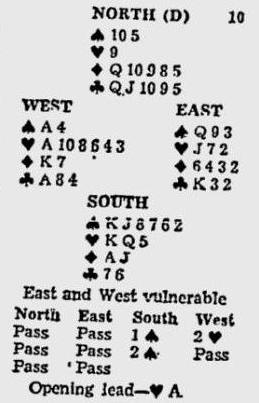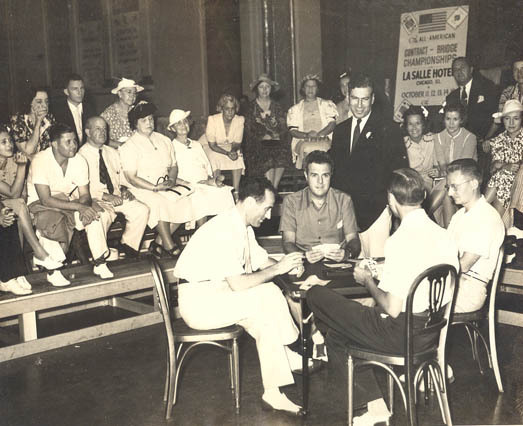Ottawa Citizen – May 1, 1965 by Oswald and Jim Jacoby

The oldest and most coveted national bridge trophy is the Vanderbilt Cup which was put into play in 1929. This year it was won by Oswald and Jim Jacoby playing with Albert Weiss DC Chicago, Phillip Feigesman 0f New York, Ira Rubin of Fairlawn N.J ., and Dr. John Fisher of Dallas. It was the second Vanderbilt win for Weiss; the seventh for Jacoby senior and the first for each other team member. This article will feature father-son discussions of a hand from the competition.
Jim: «You played throughout with Ira Rubin What would you say was the strongest feature of his game!»
Oswald: «I would say that it was his ability to judge close competitive situations and his unwillingness to sell out at a low level. His two spade bid with the South hand is a good example.
Jim: «He went down one at two spades, didn’t he?»
Oswald: «Yes. West opened the ace of hearts and continued the suit and Ira wound up losing two trumps, a heart, a diamond and two clubs. The score at our table was 50 points· for our opponents.»
Jim: «At the other table Phil Feldesman played the hand at two hearts after South failed to make a second bid. Phil won the spade opening and played ace and another heart. He wound up two hearts and one trick in each other suit to give our team a score of 110 points at his table.»
Oswald: «The net of 60 points was worth two International match points to us. If East doubled we would have broken even on the hand since 10 point net is not counted in IMP scoring. Had East gone to three hearts his partner might conceivably have made It but on any fairly normal play he would have gone down one and we would have been plus at both tables.»

Csbnews.org Note: Ira Rubin was a champion bridge player and an innovative theorist who was nicknamed the Beast because of the emotional intensity of his play. Mr. Rubin earned 19 national team titles and one world team title during his four decades as a top competitor. In 2000 he was inducted into the Hall of Fame of the American Contract Bridge League, the principal organizing body for bridge tournaments in North America. Mr. Rubin’s main theoretical contributions were in the field of bidding. The bidding systems Mr. Rubin invented were known by the names “two-way two-bids,” “Gladiator” and “Extended Landy.”
